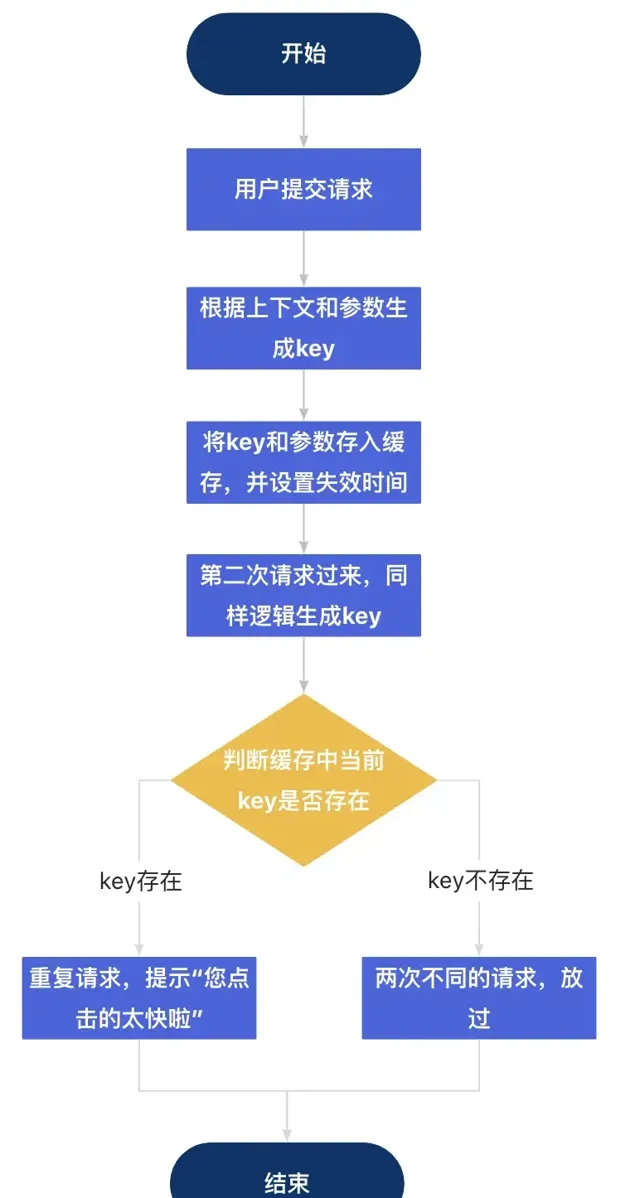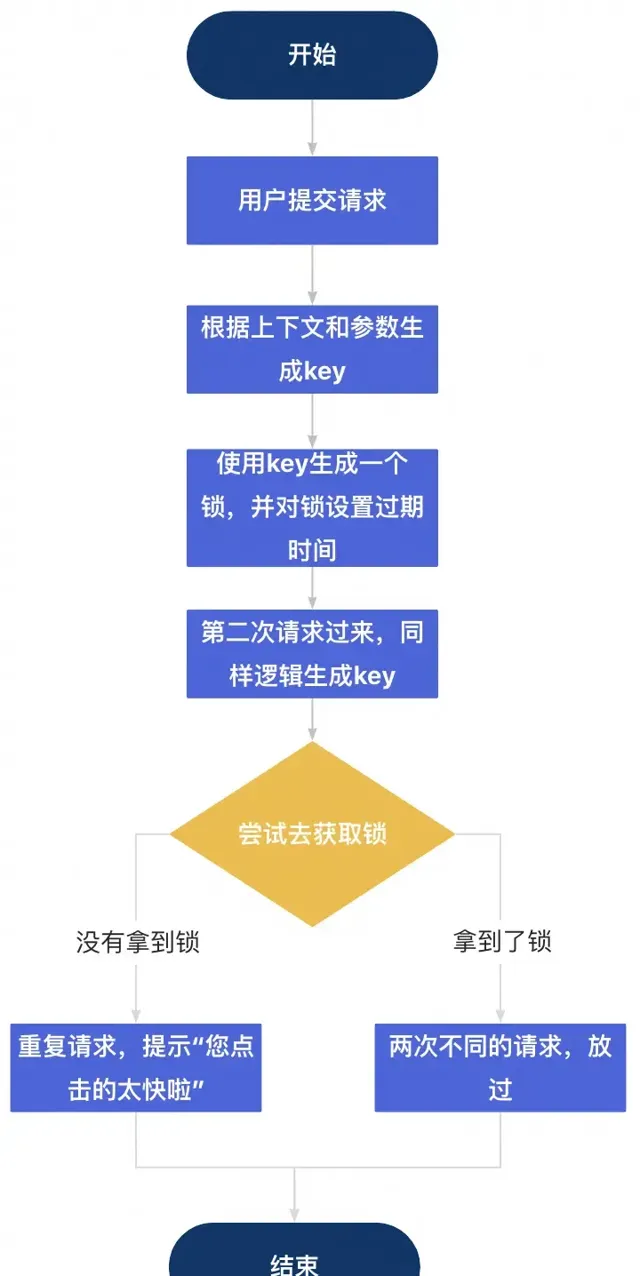點選關註公眾號,Java幹貨 及時送達 👇
作為一名老碼農,在開發後端Java業務系統,包括各種管理後台和小程式等。在這些計畫中,我設計過單/多租戶體系系統,對接過許多開放平台,也搞過訊息中心這類較為復雜的套用,但幸運的是,我至今還沒有遇到過線上系統由於程式碼崩潰導致資損的情況。這其中的原因有三點:
一是業務系統本身並不復雜;
二是我一直遵循某大廠程式碼規約,在開發過程中盡可能按規約編寫程式碼;
三是經過多年的開發經驗積累,我成為了一名熟練工,掌握了一些實用的技巧。
啥是防抖

一個理想的防抖元件或機制,我覺得應該具備以下特點:
邏輯正確,也就是不能誤判;
響應迅速,不能太慢;
易於整合,邏輯與業務解耦;
良好的使用者反饋機制,比如提示「您點選的太快了」
思路解析
前面講了那麽多,我們已經知道介面的防抖是很有必要的了,但是在開發之前,我們需要捋清楚幾個問題。
哪一類介面需要防抖?
介面防抖也不是每個介面都需要加,一般需要加防抖的介面有這幾類:
使用者輸入類介面:比如搜尋框輸入、表單輸入等,使用者輸入往往會頻繁觸發介面請求,但是每次觸發並不一定需要立即發送請求,可以等待使用者完成輸入一段時間後再發送請求。
按鈕點選類介面:比如送出表單、保存設定等,使用者可能會頻繁點選按鈕,但是每次點選並不一定需要立即發送請求,可以等待使用者停止點選一段時間後再發送請求。
捲動載入類介面:比如下拉重新整理、上拉載入更多等,使用者可能在捲動過程中頻繁觸發介面請求,但是每次觸發並不一定需要立即發送請求,可以等待使用者停止捲動一段時間後再發送請求。
如何確定介面是重復的?
防抖也即防重復送出,那麽如何確定兩次介面就是重復的呢?首先,我們需要給這兩次介面的呼叫加一個時間間隔,大於這個時間間隔的一定不是重復送出;其次,兩次請求送出的參數比對,不一定要全部參數,選擇標識性強的參數即可;最後,如果想做的更好一點,還可以加一個請求地址的對比。
分布式部署下如何做介面防抖?
有兩個方案:
使用共享緩存
流程圖如下:

使用分布式鎖
流程圖如下:

常見的分布式元件有Redis、Zookeeper等,但結合實際業務來看,一般都會選擇Redis,因為Redis一般都是Web系統必備的元件,不需要額外搭建。
具體實作
現在有一個保存使用者的介面
@PostMapping("/add")
@RequiresPermissions(value = "add")
@Log(methodDesc = "添加使用者")
public ResponseEntity<String> add(@RequestBody AddReq addReq){
return userService.add(addReq);
}
AddReq.java
package com.summo.demo.model.request;
import java.util.List;
import lombok.Data;
@Datapublic classAddReq{
/** * 使用者名稱稱 */private String userName;
/** * 使用者手機號 */private String userPhone;
/** * 角色ID列表 */private List<Long> roleIdList;}
目前資料庫表中沒有對userPhone欄位做UK索引,這就會導致每呼叫一次add就會建立一個使用者,即使userPhone相同。
請求鎖
根據上面的要求,我定了一個註解@RequestLock,使用方式很簡單,把這個註解打在介面方法上即可。
RequestLock.java
package com.summo.demo.model.request;
import java.util.List;
import lombok.Data;
@Data
public classAddReq{
/**
* 使用者名稱稱
*/
private String userName;
/**
* 使用者手機號
*/
private String userPhone;
/**
* 角色ID列表
*/
private List<Long> roleIdList;
}
@RequestLock註解定義了幾個基礎的內容,redis鎖字首、redis鎖時間、redis鎖時間單位、key分隔符。其中前面三個參數比較好理解,都是一個鎖的基本資訊。key分隔符是用來將多個參數合並在一起的,比如userName是張三,userPhone是123456,那麽完整的key就是"張三&123456",最後再加上redis鎖字首,就組成了一個唯一key。
唯一key生成
這裏有些同學可能就要說了,直接拿參數來生成key不就行了嗎?額,不是不行,但我想問一個問題:如果這個介面是文章釋出的介面,你也打算把內容當做key嗎?要知道,Redis的效率跟key的大小息息相關。所以,我的建議是選取合適的欄位作為key就行了,沒必要全都加上。
要做到參數可選,那麽用註解的方式最好了,註解如下RequestKeyParam.java
package com.example.requestlock.lock.annotation;
import java.lang.annotation.*;
/**
* @description 加上這個註解可以將參數設定為key
*/
@Target({ElementType.METHOD, ElementType.PARAMETER, ElementType.FIELD})
@Retention(RetentionPolicy.RUNTIME)
@Documented
@Inherited
public@interface RequestKeyParam {
}
這個註解加到參數上就行,沒有多余的內容。
接下來就是lockKey的生成了,程式碼如下RequestKeyGenerator.java
import java.lang.annotation.Annotation;
import java.lang.reflect.Field;
import java.lang.reflect.Method;
import java.lang.reflect.Parameter;
import org.aspectj.lang.ProceedingJoinPoint;
import org.aspectj.lang.reflect.MethodSignature;
import org.springframework.util.ReflectionUtils;
import org.springframework.util.StringUtils;
public classRequestKeyGenerator{
/**
* 獲取LockKey
*
* @param joinPoint 切入點
* @return
*/
publicstatic String getLockKey(ProceedingJoinPoint joinPoint){
//獲取連線點的方法簽名物件
MethodSignature methodSignature = (MethodSignature)joinPoint.getSignature();
//Method物件
Method method = methodSignature.getMethod();
//獲取Method物件上的註解物件
RequestLock requestLock = method.getAnnotation(RequestLock. class);
//獲取方法參數
final Object[] args = joinPoint.getArgs();
//獲取Method物件上所有的註解
final Parameter[] parameters = method.getParameters();
StringBuilder sb = new StringBuilder();
for (int i = 0; i < parameters.length; i++) {
final RequestKeyParam keyParam = parameters[i].getAnnotation(RequestKeyParam. class);
//如果內容不是RequestKeyParam註解,則不處理
if (keyParam == null) {
continue;
}
//如果內容是RequestKeyParam註解,則拼接 連線符 "& + RequestKeyParam"
sb.append(requestLock.delimiter()).append(args[i]);
}
//如果方法上沒有加RequestKeyParam註解
if (StringUtils.isEmpty(sb.toString())) {
//獲取方法上的多個註解(為什麽是兩層陣列:因為第二層陣列是只有一個元素的陣列)
final Annotation[][] parameterAnnotations = method.getParameterAnnotations();
//迴圈註解
for (int i = 0; i < parameterAnnotations.length; i++) {
final Object object = args[i];
//獲取註解類中所有的內容欄位
final Field[] fields = object.get class().getDeclaredFields();
for (Field field : fields) {
//判斷欄位上是否有RequestKeyParam註解
final RequestKeyParam annotation = field.getAnnotation(RequestKeyParam. class);
//如果沒有,跳過
if (annotation == null) {
continue;
}
//如果有,設定Accessible為true(為true時可以使用反射存取私有變量,否則不能存取私有變量)
field.setAccessible(true);
//如果內容是RequestKeyParam註解,則拼接 連線符" & + RequestKeyParam"
sb.append(requestLock.delimiter()).append(ReflectionUtils.getField(field, object));
}
}
}
//返回指定字首的key
return requestLock.prefix() + sb;
}
}
由於
@RequestKeyParam
可以放在方法的參數上,也可以放在物件的內容上,所以這裏需要進行兩次判斷,一次是獲取方法上的註解,一次是獲取物件裏面內容上的註解。
重復送出判斷
Redis緩存方式
RedisRequestLockAspect.java
import java.lang.reflect.Method;
import com.summo.demo.exception.biz.BizException;
import com.summo.demo.model.response.ResponseCodeEnum;
import org.aspectj.lang.ProceedingJoinPoint;
import org.aspectj.lang.annotation.Around;
import org.aspectj.lang.annotation.Aspect;
import org.aspectj.lang.reflect.MethodSignature;
import org.springframework.beans.factory.annotation.Autowired;
import org.springframework.context.annotation.Configuration;
import org.springframework.core.annotation.Order;
import org.springframework.data.redis.connection.RedisStringCommands;
import org.springframework.data.redis.core.RedisCallback;
import org.springframework.data.redis.core.StringRedisTemplate;
import org.springframework.data.redis.core.types.Expiration;
import org.springframework.util.StringUtils;
/**
* @description 緩存實作
*/
@Aspect
@Configuration
@Order(2)
public classRedisRequestLockAspect{
privatefinal StringRedisTemplate stringRedisTemplate;
@Autowired
publicRedisRequestLockAspect(StringRedisTemplate stringRedisTemplate){
this.stringRedisTemplate = stringRedisTemplate;
}
@Around("execution(public * * (..)) && @annotation(com.summo.demo.config.requestlock.RequestLock)")
public Object interceptor(ProceedingJoinPoint joinPoint){
MethodSignature methodSignature = (MethodSignature)joinPoint.getSignature();
Method method = methodSignature.getMethod();
RequestLock requestLock = method.getAnnotation(RequestLock. class);
if (StringUtils.isEmpty(requestLock.prefix())) {
thrownew BizException(ResponseCodeEnum.BIZ_CHECK_FAIL, "重復送出字首不能為空");
}
//獲取自訂key
final String lockKey = RequestKeyGenerator.getLockKey(joinPoint);
// 使用RedisCallback介面執行set命令,設定鎖鍵;設定額外選項:過期時間和SET_IF_ABSENT選項
final Boolean success = stringRedisTemplate.execute(
(RedisCallback<Boolean>)connection -> connection.set(lockKey.getBytes(), newbyte[0],
Expiration.from(requestLock.expire(), requestLock.timeUnit()),
RedisStringCommands.SetOption.SET_IF_ABSENT));
if (!success) {
thrownew BizException(ResponseCodeEnum.BIZ_CHECK_FAIL, "您的操作太快了,請稍後重試");
}
try {
return joinPoint.proceed();
} catch (Throwable throwable) {
thrownew BizException(ResponseCodeEnum.BIZ_CHECK_FAIL, "系統異常");
}
}
}
這裏的核心程式碼是stringRedisTemplate.execute裏面的內容,正如註釋裏面說的「使用RedisCallback介面執行set命令,設定鎖鍵;設定額外選項:過期時間和SET_IF_ABSENT選項」,有些同學可能不太清楚SET_IF_ABSENT是個啥,這裏我解釋一下:SET_IF_ABSENT是 RedisStringCommands.SetOption 列舉類中的一個選項,用於在執行 SET 命令時設定鍵值對的時候,如果鍵不存在則進行設定,如果鍵已經存在,則不進行設定。
Redisson分布式方式
Redisson分布式需要一個額外依賴,引入方式
<dependency>
<groupId>org.redisson</groupId>
<artifactId>redisson-spring-boot-starter</artifactId>
<version>3.10.6</version>
</dependency>
由於我之前的程式碼有一個RedisConfig,引入Redisson之後也需要單獨配置一下,不然會和RedisConfig沖突RedissonConfig.java
import org.redisson.Redisson;
import org.redisson.api.RedissonClient;
import org.redisson.config.Config;
import org.springframework.context.annotation.Bean;
import org.springframework.context.annotation.Configuration;
@Configuration
public classRedissonConfig{
@Bean
public RedissonClient redissonClient(){
Config config = new Config();
// 這裏假設你使用單節點的Redis伺服器
config.useSingleServer()
// 使用與Spring Data Redis相同的地址
.setAddress("redis://127.0.0.1:6379");
// 如果有密碼
//.setPassword("xxxx");
// 其他配置參數
//.setDatabase(0)
//.setConnectionPoolSize(10)
//.setConnectionMinimumIdleSize(2);
// 建立RedissonClient例項
return Redisson.create(config);
}
}
配好之後,核心程式碼如下RedissonRequestLockAspect.java
mport java.lang.reflect.Method;
import com.summo.demo.exception.biz.BizException;
import com.summo.demo.model.response.ResponseCodeEnum;
import org.aspectj.lang.ProceedingJoinPoint;
import org.aspectj.lang.annotation.Around;
import org.aspectj.lang.annotation.Aspect;
import org.aspectj.lang.reflect.MethodSignature;
import org.redisson.api.RLock;
import org.redisson.api.RedissonClient;
import org.springframework.beans.factory.annotation.Autowired;
import org.springframework.context.annotation.Configuration;
import org.springframework.core.annotation.Order;
import org.springframework.util.StringUtils;
/**
* @description 分布式鎖實作
*/
@Aspect
@Configuration
@Order(2)
public classRedissonRequestLockAspect{
private RedissonClient redissonClient;
@Autowired
publicRedissonRequestLockAspect(RedissonClient redissonClient){
this.redissonClient = redissonClient;
}
@Around("execution(public * * (..)) && @annotation(com.summo.demo.config.requestlock.RequestLock)")
public Object interceptor(ProceedingJoinPoint joinPoint){
MethodSignature methodSignature = (MethodSignature)joinPoint.getSignature();
Method method = methodSignature.getMethod();
RequestLock requestLock = method.getAnnotation(RequestLock. class);
if (StringUtils.isEmpty(requestLock.prefix())) {
thrownew BizException(ResponseCodeEnum.BIZ_CHECK_FAIL, "重復送出字首不能為空");
}
//獲取自訂key
final String lockKey = RequestKeyGenerator.getLockKey(joinPoint);
// 使用Redisson分布式鎖的方式判斷是否重復送出
RLock lock = redissonClient.getLock(lockKey);
boolean isLocked = false;
try {
//嘗試搶占鎖
isLocked = lock.tryLock();
//沒有拿到鎖說明已經有了請求了
if (!isLocked) {
thrownew BizException(ResponseCodeEnum.BIZ_CHECK_FAIL, "您的操作太快了,請稍後重試");
}
//拿到鎖後設定過期時間
lock.lock(requestLock.expire(), requestLock.timeUnit());
try {
return joinPoint.proceed();
} catch (Throwable throwable) {
thrownew BizException(ResponseCodeEnum.BIZ_CHECK_FAIL, "系統異常");
}
} catch (Exception e) {
thrownew BizException(ResponseCodeEnum.BIZ_CHECK_FAIL, "您的操作太快了,請稍後重試");
} finally {
//釋放鎖
if (isLocked && lock.isHeldByCurrentThread()) {
lock.unlock();
}
}
}
}
Redisson的核心思路就是搶鎖,當一次請求搶到鎖之後,對鎖加一個過期時間,在這個時間段內重復的請求是無法獲得這個鎖,也不難理解。
測試一下。
第一次送出,"添加使用者成功"

短時間內重復送出,"BIZ-0001:您的操作太快了,請稍後重試"

過幾秒後再次送出,"添加使用者成功"

從測試的結果上看,防抖是做到了,但是隨著緩存消失、鎖失效,還是可以發起同樣的請求,所以要真正做到介面冪等性,還需要業務程式碼的判斷、設定資料庫表的UK索引等操作。我在文章裏面說到生成唯一key的時候沒有加使用者相關的資訊,比如使用者ID、IP屬地等,真實生產環境建議加上這些,可以更好地減少誤判。
來源:juejin.cn/post/7308992638468227109
END
看完本文有收獲?請轉發分享給更多人
關註「Java編程鴨」,提升Java技能
關註Java編程鴨微信公眾號,後台回復:碼農大禮包可以獲取最新整理的技術資料一份。涵蓋Java 框架學習、架構師學習等!
文章有幫助的話,在看,轉發吧。
謝謝支持喲 (*^__^*)











